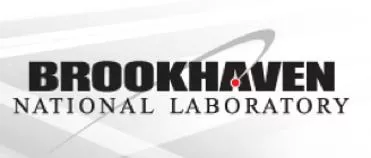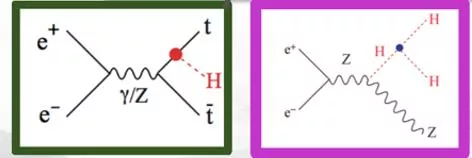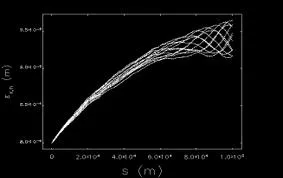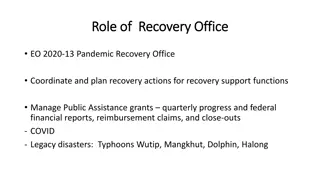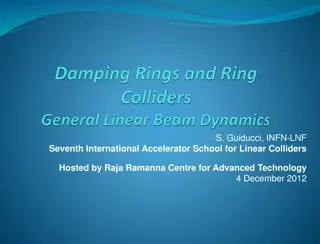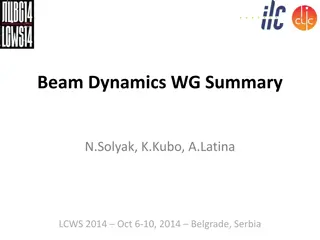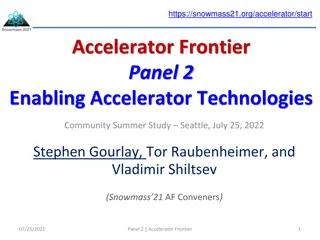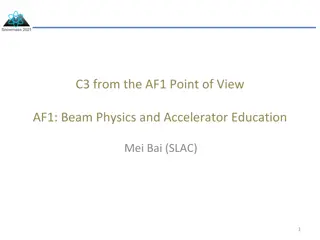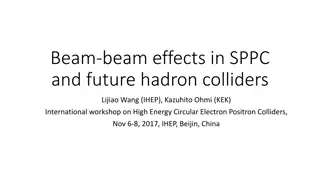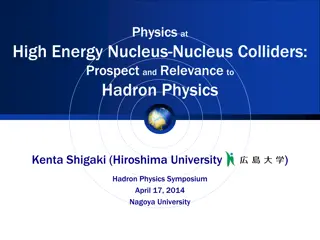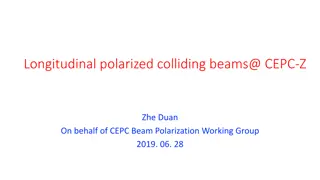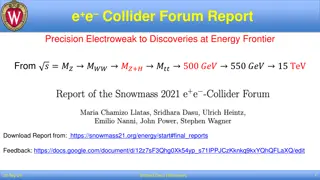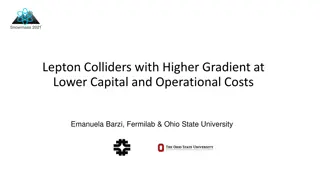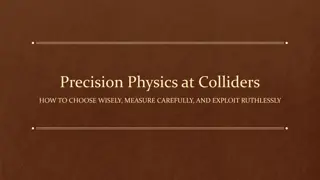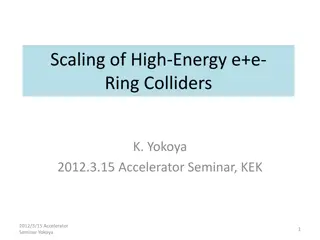Colliders using Energy-Recovery Linacs
Developments in high-energy e+e- colliders using Energy-Recovery Linacs have led to key concepts like CERC and ReLiC, aiming to enhance luminosity and energy reach. These advancements involve detailed accelerator simulations, flat low emittance beams, energy recycling and reuse, and the possibility of colliding polarized electron and positron beams. Motivations include achieving higher energy levels for specific particle productions. The table showcases parameters for CERC and ReLiC in terms of energy, accelerator length, bunches, particles, collision frequency, and luminosity.
Download Presentation

Please find below an Image/Link to download the presentation.
The content on the website is provided AS IS for your information and personal use only. It may not be sold, licensed, or shared on other websites without obtaining consent from the author.If you encounter any issues during the download, it is possible that the publisher has removed the file from their server.
You are allowed to download the files provided on this website for personal or commercial use, subject to the condition that they are used lawfully. All files are the property of their respective owners.
The content on the website is provided AS IS for your information and personal use only. It may not be sold, licensed, or shared on other websites without obtaining consent from the author.
E N D
Presentation Transcript
High Energy High Luminosity e+e- Colliders using Energy-Recovery Linacs Nikhil Bachhawat, Yichao Jing, Vladimir N Litvinenko, Francois Meot, Maria Chamizo Llatas and Thomas Roser Key development: two concepts including CERC (Circular Energy-Recovery Collider) and ReLiC (Recycling Linear Collider) Physics: Investigating details of: Accelerator: Developing detailed start-to-end simulations Checked possibility of colliding polarized electron and position beams
Key for both concepts Using linear collider approach for IRs: flat low emittance beams with large vertical disruption parameters Recycling as much as possible of the beam energy Recycle and re-use collided electrons and positrons Use damping rings to prepare recycled beams for next collisions Resulting in Increased luminosity and energy reach when compared with competing approaches Possibility of colliding highly polarized electron and position beams
Motivation 1 energy reach FCC ee ReLiC CERC An ERL e+e- collider would provide higher luminosity and high-energy up to c.m. energy of 600 GeV to enable double-Higgs and ttbarH production
Motivation 2: Luminosity Green curve ReLiC, Recycling Linear Collider Violet curve : CERC, Circular ERL collider, with 30 MW of synchrotron radiation Red curve for CIRC with 100 MW of synchrotron radiation (as in FCC ee) ReLiC Energy conservative Possible performance ReLiC CERC-100 CERC-30 CERC-100 CERC-30 FCC ee FCC ee CLIC CLIC
Table for two energies Collder C.M. energy Length of accelerator Section length Bunches per train Particles per bunch Collision frequency Beam current x, norm y, norm x y, matched z Dx Dy Total luminosity e+e- GeV km m CERC ReLiC 240 100 n/a 1 15.600 0.099 2.5 3.9 7.8 1.75 0.29 3 0.3 544 93 600 100 n/a 1 11.9 0.009 0.17 7.8 7.8 3 1 10 0.3 492 4.4 240 20 100 10 2 3.7 12.0 4 1 5 0.34 1 0.01 43 215 3000 360 100 21 1 12.6 20.2 4 1 100 20 50 0.01 32 66 1010 MHz mA mm mrad m mrad m mm mm 1034 cm-2sec-1
CERC - Circular ERL Collider Damp electron ring Damping positron ring Flat beams cooled in damping rings with top off for burn-off Bunches are ejected with collision frequency Beams accelerated with SRF linacs over four 100 km long passes by-passing the IR After collision at top energy rf phases are changed to deceleration returning most energy to SRF linac Decelerated beams are reinjected into cooling rings, after few damping times the trip repeats Luminosity is shared between detectors in any desirable ratio Only beams at top energy pass through detectors, the rest of beams bypass them CERC recycles (polarized) electrons and positrons After acceleration, collision, and deceleration all electrons and positrons are reinjected into the cooling rings. Only beam losses must be made up through top-off injection.
ReLiC Recycling Linear Collider Decompress Compress / Detectors Positron source Damping rings e+ e+ Damping rings e+ e- Compress / Decompress Separator Separator Separator Separator Linac Linac e- Linac Linac Linac e+ Linac e- e- Electron source e- e+ h h h h h e+ e- Flat beams cooled in damping rings with top off for burn-off Bunches are ejected with collision frequency, determined by the distance between beam separators Beams are accelerated on-axis in SRF linacs collide in one of detectors After collision at the top energy, they are decelerated in the opposite linacs Decelerated beams are injected into cooling rings After few damping times the trip repeats in the opposite direction and beams collide in a detector located in the opposite branch of the final separator .. ReLiC collider recycles (polarized) electrons and positrons After acceleration, collision, and deceleration all electrons and positrons are reinjected into the cooling rings. Only beam losses must be made up through top-off injection.
Impact of polarization The proper combination of polarization for electrons and positrons will significantly enhance the production cross section or will suppress it.
Agora: ITF Comparison Categories CERC-30 ReLiC CoM Energy and expandability, GeV 46 -600 46-3,000 Peak Luminosity (1034 cm-2 s-1) 4 - 94 66 - 250 IP difficulties, beamstrahlung beamstrahlung none Length of facility, km 100 20-360 Length of new accelerators, km 800 20-360 Flat beam Flat beam Beam parameters challenges (e+, alignment ) Special technologies High Q SRF HF kickers High Q SRF HF kickers R&D 5 year, 2035 R&D/validation (yrs. needed); constr. start year R&D 5 year, 2030 Construction time, yrs. 5-10 5-15 (upgrages) Cost (wrt ILC) (+/-, %), level of maturity 50%, concept 100%, concept Environment issues: AC power consumption of facility, resources (Nb, LHe ) needed 61-216 Nb, LHe 100 440 Nb, LHe 9
Technical Maturity Overall Technical Maturity: 1 Significant R&D required Critical Technologies High Q for low frequency SRF cavities, needed R&D High rep-rate kickers, needed R&D Flat beams with h/ v =1,000, needed R&D Technically limited timeline Upgrades Constructi on R&D 5 10 15 20 1/7/22 Snowmass Agora 2: Circular e+e- Colliders 10
Conclusions CERC: energy reach 500-to-600 GeV Originally published in Phys. Lett. B Volume 804, 135394, (2020) We updated beam parameters, specifically bunch lengths of colliding beams and energies of damping ring, to address weak low energy tail associated with beamstrahlung. Energy acceptance of the system is increased to keep particle loss bellow 1 p.p.m. Preliminary simulations confirmed our expectation that system will be capable of sustaining high degree of polarization in both electron and position beams We developed a straw-man lattice and performed initial tracking simulation Main challenges maintaining flatness of beams in transport and high rep-rate kickers ReLiC: energy reach tested to 3TeV, further increase is possible The concept also can be used for pulsed SRF linac, with the average luminosity reduced proportionally to the duty factors While this approach was rather obvious when we publish our CERC paper, we had not time to explore it till this November. While it is much simpler, it is also less explored In contrast with circular ERL, synchrotron radiation losses and emittance growth can be kept ay negligible level in separators. This is indication that c.m. energy can be extended to 3 TeV. Main energy losses will occur in damping rings, with operating energies ~ 2 GeV Main challenges MHz rep-rate of kickers, high SR power in damping ring Detailed studies and extensive R&D are needed to fully validate both of concepts





